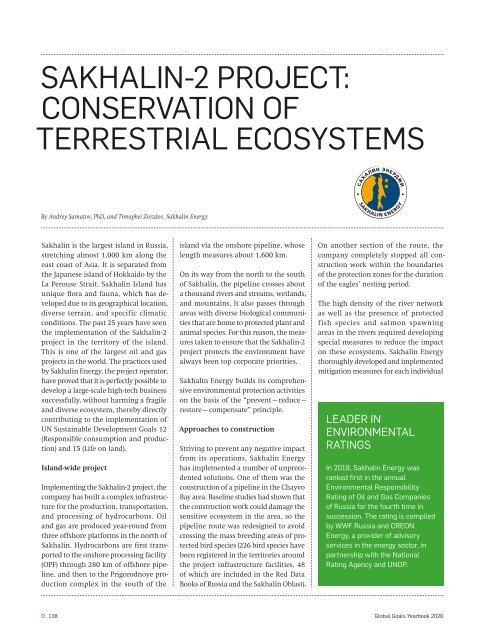Planet under Pressure
The 2020s are the make-or-break decade for Sustainability. But Covid-19 questions almost everything. How can we handle increasingly frequent shocks? What can a resilient society and economy that is in line with planetary boundaries look like? These and many other questions are discussed in the new 2020 edition of the Global Goals Yearbook titled “Planet under Pressure”. The Yearbook supports the UN Sustainable Development Goals and is one of the publications in strong international demand.
The 2020s are the make-or-break decade for Sustainability. But Covid-19 questions almost everything. How can we handle increasingly frequent shocks? What can a resilient society and economy that is in line with planetary boundaries look like? These and many other questions are discussed in the new 2020 edition of the Global Goals Yearbook titled “Planet under Pressure”. The Yearbook supports the UN Sustainable Development Goals and is one of the publications in strong international demand.
You also want an ePaper? Increase the reach of your titles
YUMPU automatically turns print PDFs into web optimized ePapers that Google loves.
SAKHALIN-2 PROJECT:<br />
CONSERVATION OF<br />
TERRESTRIAL ECOSYSTEMS<br />
By Andrey Samatov, PhD, and Timophei Zvezdov, Sakhalin Energy<br />
Sakhalin is the largest island in Russia,<br />
stretching almost 1,000 km along the<br />
east coast of Asia. It is separated from<br />
the Japanese island of Hokkaido by the<br />
La Perouse Strait. Sakhalin Island has<br />
unique flora and fauna, which has developed<br />
due to its geographical location,<br />
diverse terrain, and specific climatic<br />
conditions. The past 25 years have seen<br />
the implementation of the Sakhalin-2<br />
project in the territory of the island.<br />
This is one of the largest oil and gas<br />
projects in the world. The practices used<br />
by Sakhalin Energy, the project operator,<br />
have proved that it is perfectly possible to<br />
develop a large-scale high-tech business<br />
successfully, without harming a fragile<br />
and diverse ecosystem, thereby directly<br />
contributing to the implementation of<br />
UN Sustainable Development Goals 12<br />
(Responsible consumption and production)<br />
and 15 (Life on land).<br />
Island-wide project<br />
Implementing the Sakhalin-2 project, the<br />
company has built a complex infrastructure<br />
for the production, transportation,<br />
and processing of hydrocarbons. Oil<br />
and gas are produced year-round from<br />
three offshore platforms in the north of<br />
Sakhalin. Hydrocarbons are first transported<br />
to the onshore processing facility<br />
(OPF) through 280 km of offshore pipeline,<br />
and then to the Prigorodnoye production<br />
complex in the south of the<br />
island via the onshore pipeline, whose<br />
length measures about 1,600 km.<br />
On its way from the north to the south<br />
of Sakhalin, the pipeline crosses about<br />
a thousand rivers and streams, wetlands,<br />
and mountains. It also passes through<br />
areas with diverse biological communities<br />
that are home to protected plant and<br />
animal species. For this reason, the measures<br />
taken to ensure that the Sakhalin-2<br />
project protects the environment have<br />
always been top corporate priorities.<br />
Sakhalin Energy builds its comprehensive<br />
environmental protection activities<br />
on the basis of the “prevent–reduce–<br />
restore–compensate” principle.<br />
Approaches to construction<br />
Striving to prevent any negative impact<br />
from its operations, Sakhalin Energy<br />
has implemented a number of unprecedented<br />
solutions. One of them was the<br />
construction of a pipeline in the Chayvo<br />
Bay area. Baseline studies had shown that<br />
the construction work could damage the<br />
sensitive ecosystem in the area, so the<br />
pipeline route was redesigned to avoid<br />
crossing the mass breeding areas of protected<br />
bird species (226 bird species have<br />
been registered in the territories around<br />
the project infrastructure facilities, 48<br />
of which are included in the Red Data<br />
Books of Russia and the Sakhalin Oblast).<br />
On another section of the route, the<br />
company completely stopped all construction<br />
work within the boundaries<br />
of the protection zones for the duration<br />
of the eagles’ nesting period.<br />
The high density of the river network<br />
as well as the presence of protected<br />
fish species and salmon spawning<br />
areas in the rivers required developing<br />
special measures to reduce the impact<br />
on these ecosystems. Sakhalin Energy<br />
thoroughly developed and implemented<br />
mitigation measures for each individual<br />
LEADER IN<br />
ENVIRONMENTAL<br />
RATINGS<br />
In 2019, Sakhalin Energy was<br />
ranked first in the annual<br />
Environmental Responsibility<br />
Rating of Oil and Gas Companies<br />
of Russia for the fourth time in<br />
succession. The rating is compiled<br />
by WWF Russia and CREON<br />
Energy, a provider of advisory<br />
services in the energy sector, in<br />
partnership with the National<br />
Rating Agency and UNDP.<br />
138<br />
Global Goals Yearbook 2020
















